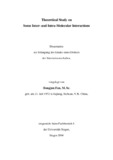Citation link:
https://nbn-resolving.org/urn:nbn:de:hbz:467-815| Dokument Type: | Doctoral Thesis | metadata.dc.title: | Theoretical study on some inter- and intra-molecular interactions | Authors: | Fan, Hongjun | Institute: | Fachbereich 8, Chemie - Biologie | Free keywords: | rotational barrier, bond expansion, reduced distance | Dewey Decimal Classification: | 540 Chemie | GHBS-Clases: | UVE | Issue Date: | 2004 | Publish Date: | 2006 | Abstract: | Ab-initio MP2&CI and DF calculations were used to study some chemical topics that involve inter- and intra-molecular so-called weak interactions. These topics include: i) What is the physical origin of the single bond rotational barrier, e.g. of ethane? Our answer is that the kinetic Pauli repulsion between CH bond pairs is much more important than hyperconjugative attraction of CH bond pairs through virtual CH σ* orbitals. ii) What is the physical origin of the bond length expansion of electron-rich main-group molecules, e.g. F 2 etc.? It is here dominantly explained by inter-atomic lone pair repulsion, with possible contributions also from atomic hybridization effects of the bonding AOs. The importance of the tails of the lone pairs is stressed. iii) What is the physical origin of reduced nonbonded interatomic separations? We found that most so-called reduced distances in the literature are simply due to the contraction of positively charged atoms. If the ubiquitous charge dependence of effective atomic radii is accounted for, a few really reduced distances survive. They are caused by specific orbital interactions of heavy nonmetal atoms, by specific charge attractions or by clamping bridges. iiii) What is the origin of the different orientations of fluorescence of dye molecules in zeolite channels? Oxonine was studied. We can explain the results of single molecule fluorescence microscopy. Correct van der Waals radii, silica - dye molecule - attractions and rotation of the optical transition moment due to orbital interactions are more important than the electrostatic Stark effect. Theoretische Studien an intra- und inter-molekularen Schwachen Wechselwirkungen Ab-initio-MP2&CI- und DF-Rechnungen wurden zur Untersuchung einiger chemischer Problem benutzt, die mit den sogenannten inter- and intra-molekularen Schwachen Wechselwirkungen zusammenhängen. i) Was ist die physikalische Ursache der Einfachbindungs-Rotationsbarriere, z.B. von Ethan? Unsere Antwort ist, dass die kinetische Pauli-Abstoßung zwischen CH-Bindungspaaren viel wichtiger ist als die hyperkonjugative Anziehung von CH-Bindungspaaren über virtuelle CH-σ*-Orbitale. ii) Was ist die physikalische Ursache der Bindungslängen-Dehnung bei elektronenreichen Hauptgruppen-Molekülen wie z.B. F 2 usw.? Wir geben eine begründete Erklärung durch interatomare Abstoßung von Einsamen Paaren, moglicherweise verstärkt durch Hybridisierungseffekte der Bindungs-AOs. Die rückwärtigen Schwänze der Einsamen Paare sind besonders relevant. iii) Was ist die physikalische Ursache der verkürzten nichtbindenden Atomabstände? Wir fanden, dass die meisten sogenannten verkürzten Abstände in der Literatur auf Vernachlässigung der Verkleinerung der Radien von positiv geladenen Atomen beruhen. Wenn die generelle Ladungsabhängigkeit der effektiven Atomradien mitberücksichtigt wird, bleiben einige wenige echt verkürzte Abstände übrig. Sie sind durch spezifische Orbitalwechselwirkungen schwerer Nichtmetallatome, durch starke Ladungs-Anziehungen oder durch klammernde Brücken verursacht. iiii) Was bedingt die unterschiedlichen Fluoreszenz-Orientierungen von Farbstoffmolekülen in Zeolith-Kanälen? Oxonin wurde studiert. Wir erklären die Ergebnisse der Einzelmolekül-Fluoreszenzmikroskopie durch Verwendung korrekter van der Waals-Radien, durch Silikat-Farbstoff-Anziehungen und durch die Drehung des optischen Übergangsmoments wegen Orbitalwechselwirkungen. Der Starkeffekt in den Kanälen spielt keine Rolle. |
URN: | urn:nbn:de:hbz:467-815 | URI: | https://dspace.ub.uni-siegen.de/handle/ubsi/81 | License: | https://dspace.ub.uni-siegen.de/static/license.txt |
| Appears in Collections: | Hochschulschriften |
This item is protected by original copyright |
Page view(s)
408
checked on Nov 28, 2024
Download(s)
246
checked on Nov 28, 2024
Google ScholarTM
Check
Items in DSpace are protected by copyright, with all rights reserved, unless otherwise indicated.


